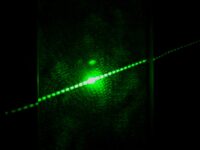Over the summer, two independent collaborations of solar physicists published breakthrough papers within months of each other, furthering our understanding of the mechanics of solar flares and how to predict them. With just four years until peak activity in the sun’s 11-year solar cycle, the ability to predict potentially dangerous solar flares is more crucial than ever.
High energy solar flares and massive ejections of solar material in the form of CMEs (coronal mass ejections) can pose a significant threat to Earth — disrupting satellites, bombarding astronauts with dangerous levels of radiation, and, in worst cases, blowing out ground transformers and crippling electric grids. While CMEs travel considerably slower than light, allowing for a short warning period of about two days, solar flares travel at the speed of light, leaving Earth quite literally in the dark until they strike. With society’s growing reliance on electronics and modern technology, predicting these solar events to provide a warning period and enact preventive measures could potentially prevent billions of dollars in damages and save lives.
But solar physics has been stalling. Empirical methods of predicting flares have fallen short of reliable and practical. To make matters worse, two decades after the discovery of “sunquakes” that ripple across the solar surface in response to solar flares, further complicating flare mechanics, scientists had made little progress in understanding how the two fundamentally relate — until now.
With society’s growing reliance on electronics and modern technology, predicting these solar events to provide a warning period and enact preventive measures could potentially prevent billions of dollars in damages and save lives
In May, an international collaboration of scientists from the United States, Colombia, and Australia published two papers announcing a breakthrough in understanding how solar flares and their accompanying sunquakes interact. The group focused on an odd M-class flare, the second-highest energy classification, which seemed to have an uncharacteristically abrupt eruption. This suddenness helped the team view the flare and its ripples with unprecedented clarity. Through a new mathematical model, the group determined that the source of the sunquake was much deeper into the sun’s surface than predicted. This led to their revolutionary hypothesis that the solar flare had not caused the sunquake ripple but that it had acted as a trigger for an energy release deeper in the sun. The scientists are optimistic about the potential implications of this discovery for the future of the field and solar flare prediction. Martínez Oliveros, a leading scientist on the papers, predicts, “We may even forecast some details about how large an active region is about to appear and what type — even, possibly, what kinds of flares — it might produce. This is a long shot, but well worth looking into.”
Not only two months later did another breakthrough shock the solar physics community — and even caught the attention of NASA. At the end of July, a team of Japanese physicists announced they had created a new model, dubbed “Kappa-Scheme,” for predicting X-class solar flares, the highest energy class and most dangerous to Earth. Unlike past empirical models, Kappa-Scheme is physics-based, meaning it models the magnetic fluid mechanics of the sun to make its predictions as opposed to relying on statistical analysis. When the team tested this new model on data from the past solar cycle, with the exception of one flare in 2014, it successfully predicted the time, solar location, and general intensity of every single X-class flare in the cycle over 20 hours before each happened. While it also threw a handful of false warnings, a model of this accuracy has never been created before.
When the team tested this new model on data from the past solar cycle, with the exception of one flare in 2014, it successfully predicted the time, solar location, and general intensity of every single X-class flare in the cycle over twenty hours before each happened.
These breakthroughs set the stage for a possible positive feedback loop in solar physics in which new understandings of flare mechanics drive more accurate physics-based prediction models, which in turn create incentives for government investment in new solar research and instrumentation to collect data. Both studies published over the summer utilized data from NASA’s Solar Dynamics Observatory satellite, and the Japanese team also pulled data from the National Oceanic and Atmospheric Administration’s Geostationary Operational Environmental Satellites (NOAA GOES) constellation.
NASA and NOAA work in collaboration to warn “electric companies, spacecraft operators and airline pilots before a CME comes to Earth so that these groups can take proper precautions.” These precautions usually include shutting down satellite systems and throttling electrical grids to handle incoming surges. With the implementation of these new scientific breakthroughs into current warning systems, the agencies could soon provide a warning period for solar flares, and an additional day cushion for CME warnings. These warnings will help mitigate one of modern technology’s greatest vulnerabilities and create an extra level of assurance for the safety of everyone on Earth.
Science (2020). DOI: 10.1126/science.aaz2511
The Astrophysical Journal Letters (2020). DOI: 10.3847/2041-8213/ab9173
The Astrophysical Journal Letters (2020). DOI: 10.3847/2041-8213/abad2a





